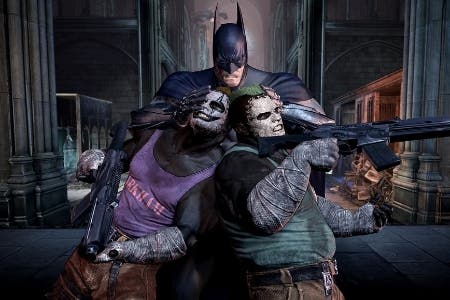Face-Off: Batman: Arkham City Armored Edition on Wii U
The killing joke?
Expectations were rather low as Batman: Arkham City Armored Edition booted up on our US import Wii U. Images like this one that emerged just after the launch suggested a game with fundamental compromises over the existing Xbox 360 release, while frame-rate analysis of the E3 trailer strongly hinted at a sub-par performance level.
The state of the game was a cause for genuine concern once we managed to get hands-on with a pre-release playable version. A post-E3 preview event revealed unfinished code plagued with bugs and texture issues - all of which didn't quite tally with press assets showing a considerably rejigged Wii U version with some image quality enhancements over the existing game.
So it's with a mixture of relief and slight disappointment that we can report that Batman: Arkham City Armored Edition is actually a pretty close match to the Xbox 360 game, from a visual standpoint at least. Those low-res shadowmaps from the now infamous screenshot? They appear to be confined to a pre-rendered video sequence, presumably dumped from the Unreal Engine editor, and are nothing more than an oversight. Existing renders from the Rocksteady work wouldn't be useable owing to the changes in character costumes.
But it's not all good news, unfortunately. There are still some LOD transition "popping" issues but the texture problems we've seen previously are all but resolved. In-game, image quality is a very close match indeed for the existing console versions. And that cuts both ways too - the changes we saw in the E3 media assets don't appear to have made it into the final game, so the rejigged LODs which brought out additional detail in some areas (and cutbacks in others) are gone - what we have here is pretty much the standard Arkham City experience.
The only real exception comes in the form of the addition of NVIDIA's FXAA post-processing technology. The original console versions of Arkham City operated at native 720p with no anti-aliasing employed at all so we might expect a welcome bump in image quality from the addition of the AA tech on Wii U. However, the arrival of FXAA is something of a double-edged sword. On the one hand, high contrast edges are smoothed significantly - a welcome addition. Unfortunately, on the flipside, the additional blurring detracts from the quality of the artwork, with specular highlights in particular dulled significantly.
But let's check out how the Wii U version compares visually with its counterparts with a series of head-to-head videos produced by matching up the new release with our existing Arkham City Face-Off assets, along with a fresh quad-format comparison gallery.
"Wii U Arkham City has much in common with the existing PS3 and Xbox 360 versions. New costumes aside, FXAA is the key addition here."
Alternative comparisons:
Anti-aliasing aside, the biggest difference from a visual standpoint is the inclusion of new "armored" costumes for both the Dark Knight and Catwoman. This covers off the inclusion of the only noticeably new plot point added to the revised game - it turns out that Waynetech has developed a new system for absorbing kinetic energy, storing it in the suit and then allowing the wearer to access it when a power gauge reaches the max, giving a short boost of additional strength.
This is accessed by the player through depressing the left and right analogue sticks simultaneously, God of War-style. The intro video for the suit suggests that the wearer turns into a rampaging powerhouse possessing superhuman strength, but the reality is that the bump in power is fairly modest.
From a narrative standpoint, quite why Catwoman gets the upgrades too isn't clear - Alfred makes reference to a "female prototype" of Batman's new suit, though why it would have been created in the first place and indeed how Selina Kyle acquires it is anyone's guess. What can be stated unequivocally is that the new costumes look hideous - Catwoman's athletic bodysuit gives way to some kind of futuristic monstrosity with glowing breasts, while Batman's new costume bears all the design hallmarks of a supermarket-exclusive action figure - with a wrist-mounted Batcomputer.
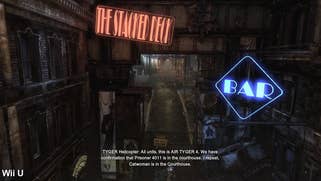


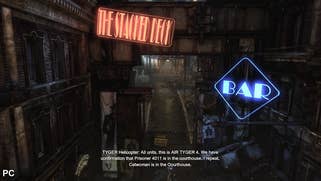
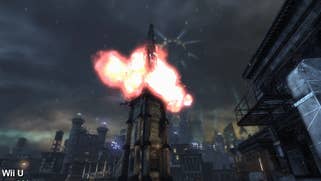
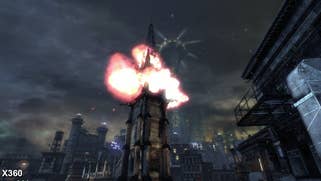
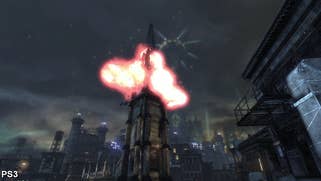
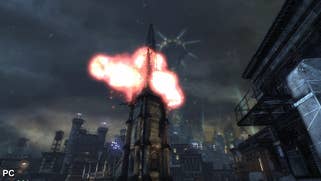
Therein lies the bulk of the Wii U exclusive features, consisting of a robust series of touch-screen based enhancements - specifically, a new spin on the Waynetech upgrade system, easier accessory management, along with touch-based maps and sonar, plus a slightly bizarre spin on the Detective Mode, where players are invited to align the GamePad to the HDTV. From there the motion sensors are used to scan around the environments, picking up evidence. Or, alternatively, don't align the screens at all and just concentrate on the touch-screen - either approach works fine.
If the touch-screen activities don't appeal to you, the game also offers a full HDTV mirroring option, meaning you can detach from the main display and play remotely. We've said it before and we'll say it again - this is an excellent feature that works beautifully and on PS3/360 ports we'd like to see it featured as standard, especially as it appears that GamePad mirroring incurs no noticeable performance hit. Just like New Super Mario Bros U and Call of Duty: Black Ops 2, the mirroring option appears to be sending a native 720p image across to the Wii U's touch-screen, which is then downscaled to fit the 480p resolution. The downgrade is noticeable, but doesn't detract from gameplay.
The Robin and Nightwing challenge rooms plus the Harley Quinn's Revenge expansion pack round-out the DLC additions bundled into the Wii U version for free.
"The new costumes only slightly alter the gameplay balance. Neither of them are going to be winning any design awards."
Arkham City: performance analysis
On Xbox 360 and PlayStation 3, we're given the standard Unreal Engine 3 performance profile. In-game, frame-rate is capped to 30FPS, with screen-tear manifesting when the engine is under stress and failing to meet the target. This helps to sustain controller latency, and while image consistency is compromised to a certain extent, the nature of the artwork makes the impact minimal. The set-up changes somewhat during cut-scenes, where input lag is not an issue - here, v-sync is employed (though we do see the odd torn frame crop up at the top of the screen when the framebuffer refresh kicks in a little late).
It's all change on Wii U though - and not for the better in our opinion. V-sync is employed throughout, working in combination with what appears to be an unlocked frame-rate. The result is messy - the consistent pad response from the Xbox 360 and PS3 games is lost and the game is plagued with judder as frame-rate zooms above - and below - the 30FPS target employed on the other console versions. Image consistency is obviously improved through the implementation of v-sync but the trade-offs in playability are not worthwhile.
To kick off with, let's take a look at a triple-format gameplay comparison encompassing a range of combat scenarios along with some open-world traversal. Xbox 360 comes off best here, doggedly maintaining its 30FPS target with only minor screen-tear issues during Batman's tour of Arkham City. In those same sections we see PS3 significantly more affected by the increased rendering load. Wii U appears to be a fairly close match for the Sony platform, but with none of the tearing problems. However, in combat it's a completely different story - decent performance on the existing current-gen platforms but noticeably sub-par results on the Wii U. In common with Mass Effect 3 and Black Ops 2, once again Wii U has trouble processing multiple characters on-screen at any given point - more evidence that the CPU is simply not up to scratch for straight PS3/360 ports without some extensive optimisation.
"Image consistency is improved a touch on Wii U thanks to v-sync, but performance is all over the place and combat in particular suffers."
Next up, a chance to look at Wii U performance on a series of engine-driven cut-scenes - our best chance at evaluating how the tech copes when handling like-for-like rendering scenarios. Unfortunately, the Wii U version's unlocked frame-rate rules out a level playing field, and in many scenes we see 40FPS readings or even higher, with the older versions firmly pegged at 30FPS. This may suggest that the Nintendo platform is out-performing the Xbox 360 and PlayStation 3, but the reality is that Rocksteady artificially cap frame-rates in order to reduce judder - something the Wii U version has in spades. The cap disappears if you use the TriOviz 3D mode though, whereupon we see similarly high frame-rates - for those wondering, stereoscopic 3D appears to be absent from the Wii U version of Arkham City.
Also note that on open-world cut-scenes and areas with plenty of characters on-screen, once again we see disappointingly low levels of performance, though we suspect that if the Wii U version employed the same "lock at 30, tear below" approach seen on PS3 and 360, the open-world elements at least would be closer to what we see on the Sony platform. The big problem with employing v-sync rigidly is that the GPU effectively stalls when a frame runs over the rendering budget, as the new image has to wait for the monitor refresh to begin.
Overall, it's fair to say that performance is the Achilles' heel of this new Armored Edition. Frame-rate varies significantly, resulting in an experience that is nowhere near as smooth or as consistently responsive as the existing versions of the game. We're not quite sure why Warner Bros.' conversion team simply didn't stick to the template laid down by the existing games - there's a reason it's in place, and it's not surprising that a similar scheme is also employed by almost every other Unreal Engine 3 title out there on current-gen console.
"Wii U's unlocked frame-rate results in some obvious judder and v-sync actually hinders performance when the engine is truly struggling."
Batman: Arkham City Armored Edition - the Digital Foundry verdict
What looked like graphical tweaks from the press materials failed to materialise - FXAA apart - but thankfully some of the more alarming reports about Wii U graphical deficiencies turned out to be of little consequence to the final product. However, what we have here is a disappointing current-gen port with some bundled DLC and some interesting - if not totally convincing - touch-screen upgrades.
The overall takeaway is that the Wii U version of this classic title is unpolished and less enjoyable to play than Rocksteady's original. On top of the variable frame-rate, we were also disappointed to see the odd moment of more noticeable LOD popping and jerky FMV sequences suggesting that this version has some streaming issues. Unreal Engine titles background load data concurrently with streaming video, and you can hear the drive head zooming about, almost as if it is struggling to maintain both tasks - the halting playback adds further to the impression that this is a rougher, jerkier, more lacklustre rendition of the original.
It's Arkham City, and by default a good game, but the basic reality is that we'd take any of the older - and now cheaper - versions of this excellent title ahead of the underwhelming Wii U port.
